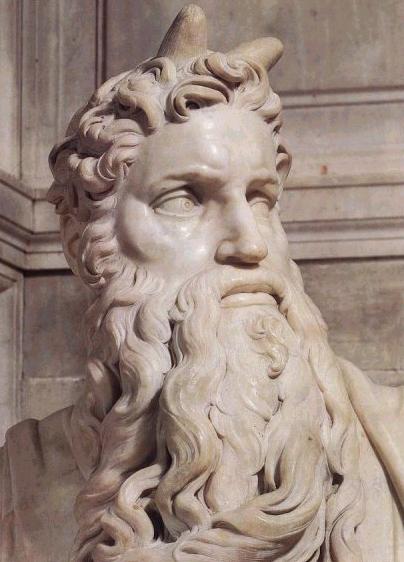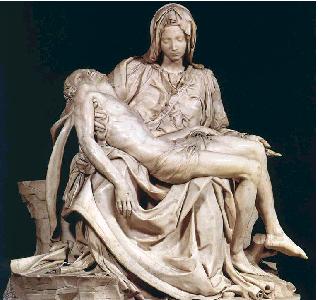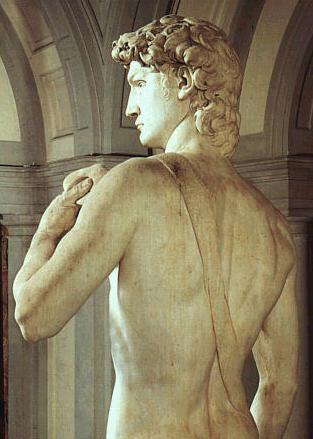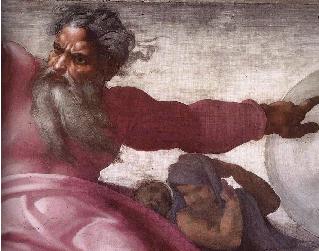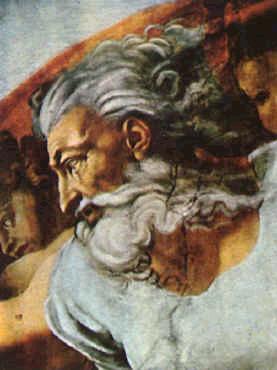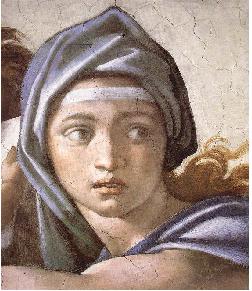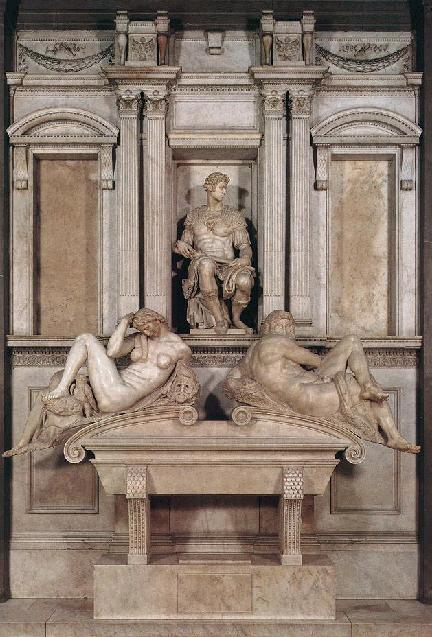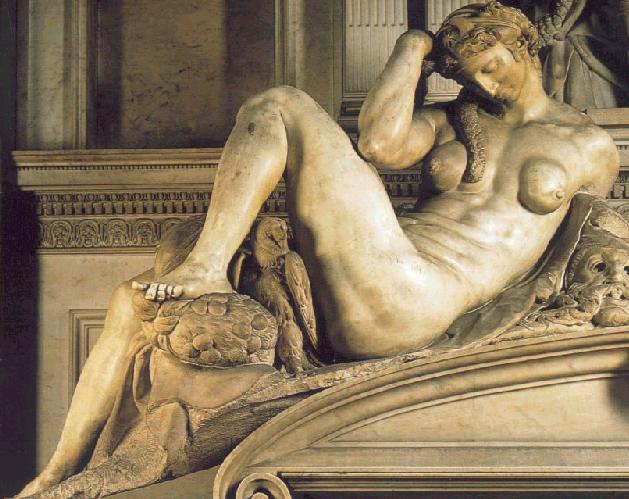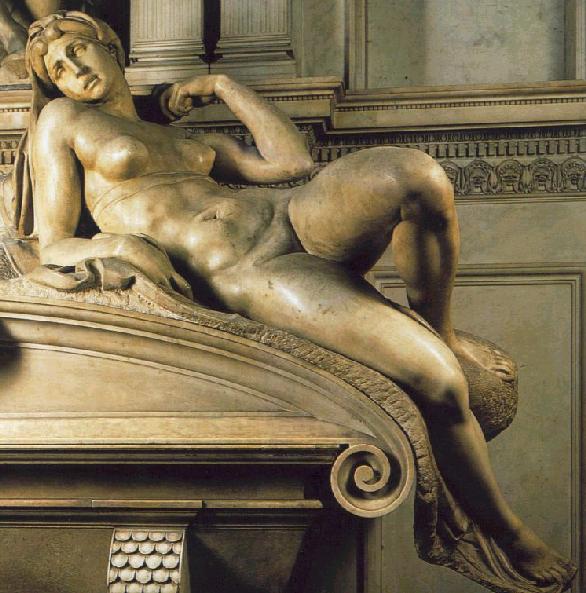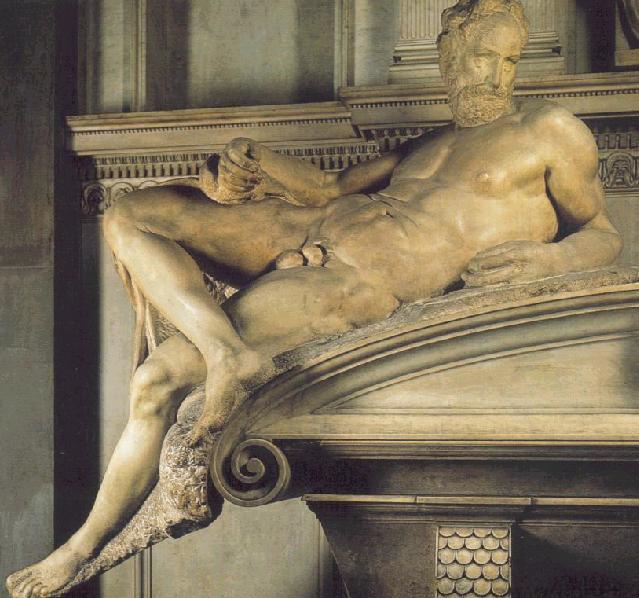
Candida Martinelli's Italophile Site

Main
Page This family-friendly site celebrates Italian culture for the enjoyment of children and
adults. Site-Overview
Knights of Art -
Michelangelo
Visit
my Angels in Italian Art Page
Visit
my Canaletto and Venice Art Page On-line images of art at Web
Gallery of Art: Sometimes
in a crowd of people one sees a tall man, who stands head and shoulders
higher than any one else, and who can look far over the heads of
ordinary- sized mortals. `What
a giant!' we exclaim, as we gaze up and see him towering above us. So
among the crowd of painters travelling along the road to Fame we see
above the rest a giant, a greater and more powerful genius than any that
came before or after him. When we hear the name of Michelangelo we
picture to ourselves a great rugged, powerful giant, a veritable son of
thunder, who, like the Titans of old, bent every force of Nature to his
will. Doni Tondo by Michelangelo This
Michelangelo was born at Caprese among the mountains of Casentino. His
father, Lodovico Buonarroti, was podesta or mayor of Caprese, and came
of a very ancient and honourable family, which had often distinguished
itself in the service of Florence. Now
the day on which the baby was born happened to be not only a Sunday, but
also a morning when the stars were especially favourable. So the wise
men declared that some heavenly virtue was sure to belong to a child
born at that particular time, and without hesitation Lodovico determined
to call his little son Michael Angelo, after the archangel Michael.
Surely that was a name splendid enough to adorn any great career. It
happened just then that Lodovico's year of office ended, and so he
returned with his wife and child to Florence. He had a property at
Settignano, a little village just outside the city, and there he settled
down. Most
of the people of the village were stone- cutters, and it was to the wife
of one of these labourers that little Michelangelo was sent to be
nursed. So in after years the great master often said that if his mind
was worth anything, he owed it to the clear pure mountain air in which
he was born, just as he owed his love of carving stone to the
unconscious influence of his nurse, the stone- cutter's wife. As
the boy grew up he clearly showed in what direction his interest lay. At
school he was something of a dunce at his lessons, but let him but have
a pencil and paper and his mind was wide awake at once. Every spare
moment he spent making sketches on the walls of his father's house. But
Lodovico would not hear of the boy becoming an artist. There were many
children to provide for, and the family was not rich. It would be much
more fitting that Michelangelo should go into the silk and woollen
business and learn to make money. Moses (detail) by Michelangelo But
it was all in vain to try to make the boy see the wisdom of all this.
Scold as they might, he cared for nothing but his pencil, and even after
he was severely beaten he would creep back to his
beloved work. How he envied his friend Francesco who worked in
the shop of Master Ghirlandaio! It was a joy even to sit and listen to
the tales of the studio, and it was a happy day when Francesco brought
some of the master's drawings to show to his eager friend. Little
by little Lodovico began to see that there was nothing for it but to
give way to the boy's wishes, and so at last, when he was fourteen years
old, Michelangelo was sent to study as a pupil in the studio of Master
Ghirlandaio. It
was just at the time when Ghirlandaio was painting the frescoes of the
chapel in Santa Maria Novella, and Michelangelo learned many lessons as
he watched the master at work, or even helped with the less important
parts. But
it was like placing an eagle in a hawk's nest. The young eagle quickly
learned to soar far higher than the hawk could do, and ere long began to
`sweep the skies alone.' It
was not pleasant for the great Florentine master, whose work all men
admired, to have his drawings corrected by a young lad, and perhaps
Michelangelo was not as humble as he should have been. In the strength
of his great knowledge he would sometimes say sharp and scornful things,
and perhaps he forgot the respect due from pupil to master. Be
that as it may, he left Ghirlandaio's studio when he was sixteen years
old, and never had another master. Thenceforward he worked out his own
ideas in his giant strength, and was the pupil of none. The
boy Francesco was still his friend, and together they went to study in
the gardens of San Marco, where Lorenzo the Magnificent had collected
many statues and works of art. Here was a new field for Michelangelo.
Without needing a lesson he began to copy the statues in terra-cotta,
and so clever was his work that Lorenzo was delighted with it. `See,
now, what thou canst do with marble,' he said. `Terra-cotta is but poor
stuff to work in.' Michelangelo
had never handled a chisel before, but he chipped and cut away the
marble so marvellously that life seemed to spring out of the stone.
There was a marble head of an old faun in the garden, and this
Michelangelo set himself to copy. Such a wonderful copy did he make that
Lorenzo was amazed. It was even better than the original, for the boy
had introduced ideas of his own and had made the laughing mouth a little
open to show the teeth and the tongue of the faun. Lorenzo noticed this,
and turned with a smile to the young artist. `Thou
shouldst have remembered that old folks never keep all their teeth, but
that some of them are always wanting,' he said. Of
course Lorenzo meant this as a joke, but Michelangelo immediately took
his hammer and struck out several of the teeth, and this too pleased
Lorenzo greatly. There
was nothing that the Magnificent ruler loved so much as genius, so
Michelangelo was received into the palace and made the companion of
Lorenzo's sons. Not only did good fortune thus smile upon the young artist, but to his great astonishment Lodovico too found
that benefits were showered upon him, all for the sake of his famous
young son. These
years of peace, and calm, steady work had the greatest effect on
Michelangelo's work, and he learned much from the clever, brilliant men
who thronged Lorenzo's court. Then, too, he first listened to that
ringing voice which strove to raise Florence to a sense of her sins,
when Savonarola preached his great sermons in the Duomo. That teaching
sank deep into the heart of Michelangelo, and years afterwards he left
on the walls of the Sistine Chapel a living echo of those thundering
words. The Pieta by Michelangelo Like
all the other artists, he would often go to study Masaccio's frescoes in
the little chapel of the Carmine. There was quite a band of young
artists working there, and very soon they began to look with envious
feelings at Michelangelo's drawings, and their jealousy grew as his fame
increased. At last, one day, a youth called Torriggiano could bear it no
longer, and began to make scornful remarks, and worked himself up into
such a rage that he aimed a blow at Michelangelo with his fist, which
not only broke his nose but crushed it in such a way that he was marked
for life. He had had a rough, rugged look before this, but now the
crooked nose gave him almost a savage expression which he never lost. Changes
followed fast after this time of quiet. Lorenzo the Magnificent died,
and his son, the weak Piero de Medici, tried to take his place as ruler
of Florence. For a time Michelangelo continued to live
at the court of Piero, but it was not encouraging to work for a
master whose foolish taste demanded statues to be made out of snow,
which, of course, melted at the first breath of spring. Michelangelo
never forgot all that he owed to Lorenzo, and he loved the Medici
family, but his sense of justice made him unable to take their part when
trouble arose between them and the Florentine people. So when the
struggle began he left Florence and went first to Venice and then to
Bologna. From afar he heard how the weak Piero had been driven out of
the city, but more bitter still was his grief when the news came that
the solemn warning voice of the great preacher Savonarola was silenced
for ever. Then
a great longing to see his beloved city again filled his heart, and he
returned to Florence. Botticelli
was a sad, broken-down old man now, and Ghirlandaio was also growing
old, but Florence was still rich in great artists. Leonardo da Vinci,
Perugino, and Filippino Lippi were all there, and men talked of the
coming of an even greater genius, the young Raphael of Urbino. There
happened just then to be at the works of the Cathedral of St. Mary of
the Flowers a huge block of marble which no one knew how to use.
Leonardo da Vinci had been invited to carve a statue out of it, but he
had refused to try, saying he could do nothing with it. But when the
marble was offered to Michelangelo his eye kindled and he stood for a
long time silent before the great white block. Through the outer walls
of stone he seemed to see the figure imprisoned in the marble, and his giant strength and giant mind
longed to go to work to set that figure free. And
when the last covering of marble was chipped and cut away there stood
out a magnificent figure of the young David. Perhaps he is too strong
and powerful for our idea of the gentle shepherd-lad, but he is a
wonderful figure, and Goliath might well have trembled to meet such a
young giant.
David
(detail) by Michelangelo People
flocked to see the great statue, and many were the discussions as to
where it should be placed. Artists were never tired of giving their
opinion, and even of criticising the work. `It seems to me,' said one,
`that the nose is surely much too large for the face. Could you not
alter that?' Michelangelo
said nothing, but he mounted the scaffolding and pretended to chip away
at the nose with his chisel. Meanwhile he let drop some marble chips and
dust upon the head of the critic beneath. Then he came down. `Is
that better?' he asked gravely. `Admirable!'
answered the artist. `You have given it life.' Michelangelo
smiled to himself. How wise people thought themselves when they often
knew nothing about what they were talking! But the critic was satisfied,
and did not notice the smile. It
would fill a book to tell of all the work which Michelangelo did; but
although he began so much, a great deal of it was left unfinished. If he
had lived in quieter times, his work would have been more complete; but
one after another his patrons died, or changed their minds, and set him
to work at something else before he had finished what he was doing. The
great tomb which Pope Julius had ordered him to make was never finished,
although Michelangelo drew out all the designs for it, and for forty
years was constantly trying to complete it. The Pope began to think it
was an evil omen to build his own tomb, so he made up his mind that
Michelangelo should instead set to work to fresco the ceiling of the
Sistine Chapel. In vain did the great sculptor repeat that he knew but
little of the art of painting. `Didst
thou not learn to mix colours in the studio of Master Ghirlandaio?' said
Julius. `Thou hast but to remember the lessons he taught thee. And,
besides, I have heard of a great drawing of a battle- scene which thou
didst make for the Florentines, and have seen many drawings of thine,
one especially: a terrible head of a furious old man, shrieking in his
rage, such as no other hand than thine could have drawn. Is there aught
that thou canst not do if thou hast but the will?' And
the Pope was right; for as soon as Michelangelo really made up his mind
to do the work, all difficulties seemed to vanish. It
was no easy task he had undertaken. To stand upright and cover vast
walls with painting is difficult enough, but Michelangelo was obliged to
lie flat upon a scaffolding and paint the ceiling above him. Even to
look up at that ceiling for ten minutes makes the head and neck ache
with pain, and we wonder how such a piece of work could ever have been
done. Creation of Sun, Moon, Planets
from Sistine Chapel by Michelangelo No
help would the master accept, and he had no pupils. Alone he worked, and
he could not bear to have any one near him looking on. In silence and
solitude he lay there painting those marvellous frescoes of the story of
the Creation to the time of Noah. Only Pope Julius himself dared to
disturb the master, and he alone climbed the scaffolding and watched the
work. `When
wilt thou have finished?' was his constant cry. `I long to show thy work
to the world.' `Patience,
patience,' said Michelangelo. `Nothing is ready yet.' `But
when wilt thou make an end?' asked the impatient old man. `When
I can,' answered the painter. Then
the Pope lost his temper, for he was not accustomed to be answered like
this. God as he gives life to Adam
from the Sistine Chapel by Michelangelo `Dost
thou want to be thrown head first from the scaffold?' he asked angrily.
`I tell thee that will happen if the work is not finished at once.' So,
incomplete as they were, Michelangelo was obliged to uncover the
frescoes that all Rome might see them. It was many years before the
ceiling was finished or the final fresco of the Last Judgment painted
upon the end wall. Michelangelo
lived to be a very old man, and his life was lonely and solitary to the
end. The one woman he loved, Vittoria Colonna, had died, and with her
death all brightness for him had faded. Although he worked so much in
Rome, it was always Florence that he loved. There it was that he began
the statues for the Chapel of the Medici, and there, too, he helped to
build the defences of San Miniato when the Medici family made war upon
the City of Flowers. Delphic Sibyl from Sistine
Chapel by Michelangelo
Part of the Medici Tomb, Florence Urbino from the Medici Tomb, Florence Night from the Medici Tomb, Florence Dawn from Medici Tomb, Florence Twilight from Medici Tomb, Florence Day from Medici Tomb, Florence
Return to:
Stories of the Italian Painters
by Amy Steedman

